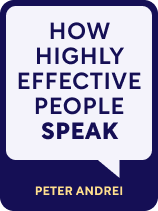

This article is an excerpt from the Shortform book guide to "How Highly Effective People Speak" by Peter Andrei. Shortform has the world's best summaries and analyses of books you should be reading.
Like this article? Sign up for a free trial here.
How can understanding cognitive biases help you communicate more effectively? Is it okay to take advantage of these flawed perceptions in others?
In How Highly Effective People Speak, Peter D. Andrei shares the basic strategies of powerful communication. He teaches you how to speak with eloquence and persuasion—not by simply repeating platitudes, but by diving into what makes them true and how they make communication more effective.
Continue reading for an overview of this book that can make you a more effective person.
How Highly Effective People Speak
Effective communication, according to Peter D. Andrei, is more of a science than most people think. It’s not, as some people believe, some obscure art that can only be mastered by the most charismatic and graceful among us. Instead, it’s a complex craft that can be studied and learned, and its strategies can be broken down and used by anyone.
Most books on speech and communication say the same things: “Keep it simple, be authentic, use emotion to persuade, speak with confidence,” and so on. In How Highly Effective People Speak, Andrei argues that most of these truisms about speech aren’t wrong, per se, but they only scratch the surface.
The key to effective communication is to understand cognitive biases: patterns of thinking that affect human behavior and perception. You can use them to persuade and influence others in predictable ways. Whether intentionally or not, the most effective speakers and writers throughout history have activated their audience’s cognitive biases to make their communication persuasive, and you can do the same.
We’ll first briefly touch on the morality of rhetoric and why appealing to cognitive biases isn’t inherently unethical. Then, we’ll explore some of the most powerful and influential biases you can use to make your communication more persuasive and effective. Then, we’ll explain Andrei’s strategies and how to practice them.
The Morality of Rhetoric
Communication, says Andrei, is about persuasion, and the morality of persuading others (that is, whether it’s right or wrong to manipulate people’s thoughts or actions with words) depends on the morality of the speaker’s intentions. Using cognitive biases to influence others may seem selfish, dishonest, or unethical, but Andrei argues that this isn’t necessarily the case.
Rhetoric, the science of persuasive speech, can be used for good or evil: to connect people, to sow division, to help people see the truth, or to make them believe in falsehoods. Thus, rhetoric is a tool you should understand how to use not for selfish or unethical reasons, but so you can persuade others according to your moral standards. Appealing to cognitive biases isn’t about lying to your audience, it’s about helping them see the truth by conveying information in the way they’re conditioned to understand it.
(Shortform note: A deeper look into morality may help further explain Andrei’s take on the morality of persuasive communication. In The Righteous Mind, Jonathan Haidt argues that morality is based on intuition rather than sound reasoning. That is, our moral standards aren’t objective truth; they’re social and cultural constructs guided by emotions more than logic. If morality isn’t based on rational thought or logic, appealing to our often irrational and emotional cognitive biases is the only way we can hope to persuade others. If morality itself is intuitive, there is nothing inherently wrong with using intuitive rhetoric to influence others.)
Let’s examine some of the most common and powerful cognitive biases you can use to make your speech more persuasive and effective.
Availability Bias
Availability bias is the tendency to give too much credence to evidence or information that comes most easily to mind—the evidence that’s mentally “available.” Relying on this type of information can allow us to make judgments quickly, which can be helpful but also can lead us to wrong judgments.
A classic example of this bias is in the common fear of plane crashes—a statistically unlikely event that people irrationally fear because they easily remember instances of it occurring.
According to Andrei, if you want your communication to be unforgettable (and thus the most readily available), it should be emotional, simple, and vivid. He offers several strategies to imbue your speech or writing with these qualities.
Use Compelling Narratives
One of the most effective ways to make your speech emotionally stimulating is to use powerful storytelling, appealing to narrative bias. People understand the world through stories—it’s how we learn and how our ancestors passed down information over thousands of years. When an argument is presented as a story, we relate to the people in the story and imagine what it would be like if the same things happened to us.
To make your stories as emotionally compelling as possible, Andrei recommends telling a story about a single person. This makes it even easier for the listener to imagine themselves in the story. Let’s say you’re making a speech about reducing the effects of pollution on a small town near a factory. You could just provide all the facts: the higher percentages of illness, the levels of toxins in the drinking water before and after the factory was built, and the economic damage to the town.
Or, more effectively, you could tell a story about one person in the town. Then, when the audience is emotionally captivated, you might add in the statistics about illness percentages or toxin levels to drive the point home. This narrative-structured speech is more likely to resonate with the audience than simply stating the facts or even telling a story about how the town as a whole was affected.
Convey a Simple Message
Another way to use the availability bias is to simplify your communication, Andrei writes. If your message is complex or difficult to understand, it won’t be as easy for people to recall this information later. At the end of your speech or essay, the audience should know exactly what they learned and what information they can take away from it.
To achieve this, provide the most important information as clearly as possible. Remove unnecessary details from a story or any information that makes your message less clear. Unnecessary details will only obfuscate the message and make it less memorable.
Use Imagery
Andrei explains that using imagery is an effective way to make your communication more memorable. This is because memories based on visual perception stick out more clearly in our minds, so they’ll provoke a stronger emotional reaction and be easier to recall later.
If possible, use pictures or other images in your speeches and writing. If you’re giving a presentation and can use a television or other technology to project images on a screen, use it. If you don’t have a way to project images, use visual imagery in your speech. Paint a picture with your words by including visual details in your story or visual metaphors in your explanations.
Attribute Substitution
Andrei says that attribute substitution is behind a variety of cognitive biases and can be used to influence your audience in subtle yet powerful ways. Attribute substitution is the tendency for people to replace a complex judgment or problem with an easier one. In other words, they substitute an attribute that’s difficult to measure with a simpler one.
Use Emotions as Replacement Attributes
Andrei contends that appealing to your audience’s emotions—one of the most common and effective persuasive techniques—is a form of attribute substitution. Instead of asking ourselves, “Is this message true?” or “Is it in my best interest to buy this product?” audiences ask, “How does this message or product make me feel?” If it makes them feel good, they’re more likely to approve of a message or purchase a product. If the idea of attracting a romantic partner makes them feel good, they’ll be motivated to buy an electric toothbrush described as a tool to increase their attractiveness.
Provide Abundant Evidence
Andrei argues that people strongly prefer to see evidence supporting a claim, and you can use this preference to make your argument more convincing—even if the evidence doesn’t actually prove your point. This is because people conflate the existence of evidence with the strength of evidence. Of course, it’s best if your evidence is strong and accurate, but simply providing evidence is often enough to seem convincing. Further, if you can provide abundant evidence, it will make the argument seem even more valid.
Present Social Proof
Another common cognitive bias Andrei points out is our overreliance on the actions and opinions of others to dictate our own. When we rely on social proof, we substitute how others think or behave with how we should think or behave. An ad that claims “nine out of 10 dentists recommend this product” is using social proof, as is a politician who says “80% of Americans support this bill.” Presenting social proof like this will validate your argument in your audience’s eyes.
The Anchoring Bias
The anchoring bias, also known as the anchoring effect, is the tendency for a person’s decisions to be excessively influenced by an initial reference point, or anchor.
The anchoring bias is largely due to our relative perception of the world. We need a point of reference, a way to contextualize information, to understand what anything means. If the salary of a job you’re applying for is $40,000, you can’t do much with this information unless you compare it to what you make now, what the average salary for this particular job is, and the cost of living in your area. Without a point of reference and additional information, the number $40,000 is useless. As Andrei points out, you might be happy with earning $40,000 a year until you learn that someone with the same job is making $50,000.
Anchoring bias is a helpful tool in persuasive speech or writing, but you can also use it to your advantage in all sorts of interactions. Whether you’re a politician persuading someone to vote for you, a new hire trying to negotiate a higher salary, or a salesperson trying to convince someone to buy a product, the anchoring bias can be used to great effect.
Use Relevant Anchors to Raise or Lower Expectations
This tactic involves setting an anchor that is directly related to the matter at hand. In its simplest form, this is the most basic negotiation tactic. If you want to buy something cheap, your original offer should be much lower than what you’re willing to pay. If you’re selling something, you start with a much higher price than you’re willing to sell for. This tactic can be used in a variety of subtle ways.
This anchoring tactic can also be used in persuasive speech or writing. Let’s say you’re a mayor running for reelection. You start your speech by pointing out that the average annual economic growth in your city over the past 20 years is 1.4%. Then, you tell your audience that over your last four years as mayor, the annual growth rate has averaged over 3%. Because of the original anchor you set, your 3% will seem a lot more impressive to potential voters and you’ll appear to be a more attractive candidate.
Use Irrelevant Anchors to Raise or Lower Expectations
Another way to engage a person’s anchoring bias that Andrei recommends is to set an anchor unrelated to the matter at hand. Let’s say you work at a wine store and want to sell more expensive bottles of wine. Instead of anchoring with a higher original price, you can anchor customers with the price of an irrelevant, but expensive, item.
Zero-Risk Bias
Andrei claims that people are irrationally biased toward ideas, products, or circumstances that carry no risk of failure or loss. We’re extremely loss-averse creatures, and we’ll often pay a hefty price to ensure we don’t suffer the pain of losing something, whether it’s our hard-earned money, our precious time, or our health and safety.
If your proposal, idea, or product is already a risk-free option, you need only emphasize it: State that it’s risk-free, show proof, then reiterate the absence of risk as often as possible. Of course, more likely than not, your idea or product will carry some risk of loss or failure. Here are some of Andrei’s strategies that take advantage of the zero-risk bias even when risk is involved.
Provide Certainty Elsewhere
If the idea you’re proposing has any chance of failure, shift the audience’s attention to a part of it that doesn’t carry any risk. If you’re trying to convince an investor to provide funding to your startup, there’s always a chance that your business will fail and they’ll lose their investment. Nothing you say will remove that risk. Instead, point to a zero-risk aspect of your startup, like the fact that you have a patent for the technology you’re using, so there’s no chance a competitor can copy your product. This will activate the zero-risk bias even if this isn’t a risk the investor had in mind, and even though your plan still carries risk, they’ll be much more inclined to invest in your startup.
Provide a Loss-Mitigating Guarantee
In the business world, a loss-mitigating guarantee is as simple as offering a full refund for a defective product or underwhelming service. Since you can’t guarantee with 100% certainty that your product or service will deliver value, provide a guarantee that the customer can at least get their money back. Because of zero-risk bias, the extra sales will more than make up for the money you’ll lose by providing refunds.
The Halo Effect
The halo effect is the tendency for people to base their overall impression of a person on one observed quality, and Andrei argues you can use this bias to make yourself appear competent and trustworthy to your audience. Essentially, the halo effect is the bias that tells us that good first impressions do matter.
The halo effect is the result of a combination of other cognitive biases, including the primacy effect, attribution substitution, and confirmation bias. When you notice an initial positive quality in a person (primacy effect), you’ll attribute a host of other positive qualities to that person (attribute substitution), and then see small signs that point to those positive qualities as confirmation of your beliefs (confirmation bias).
Here are a few of Andrei’s strategies that use the halo effect:
Create an Influential Environment
When it comes to first impressions, context matters. By creating an impressive environment, you can make a good first impression on an audience before you enter a room or utter a word. Book your speech at the most luxurious place you can afford. Give your work presentation in the best conference room available. Make the space you’re communicating in as presentable as possible, and your audience will think you’re a competent and reliable speaker before you begin. If communicating in written form, take the time to make the aesthetic as visually pleasing as you can.
Demonstrate Consequences Early
At the outset, make clear why your speech matters and the impact it will have on your audience’s lives. If your audience knows early on that what you’re about to say is important, they’ll see you as an important figure, and you’ll command their attention and respect. Conversely, if you don’t show why your speech matters early on, they’ll think you’re unimportant and boring, and you’ll have much less of an impact. Psychological studies confirm that demonstrating consequences early is an effective way to make your communication more compelling and persuasive.
A specific way to do this is to present a positive conditional statement, then a negative conditional statement, then proof—”If you do this, [positive effect] will happen. If you don’t, [negative effect] will occur. This has been shown time and time again by [proof].” The previous paragraph illustrates this technique in action.
Establish Common Values
Establishing common values with your audience early in your communication is one of the most powerful uses of the halo effect, according to Andrei. When you show you share the same values or beliefs as your audience, you establish a connection. They’ll like you immediately, and this feeling will help the rest of your speech resonate with them even more powerfully.
To employ this strategy, you either need to know your audience and the common values they’d likely share, or use a universally shared value or belief.
Contrast Effect Bias
According to Andrei, using the contrast effect in your communication is one of the most useful ways to improve your rhetorical skills. The contrast effect is the tendency to judge things presented closely together or in rapid succession together rather than separately, and it can strengthen or weaken perceived differences and similarities between two or more things. Like the anchoring bias, the contrast effect relies on our inability to judge things without a point of comparison. The contrast effect, however, doesn’t necessarily rely on the initial point of reference as the anchoring bias does. Instead, it’s activated by ongoing comparisons between two things.
Andrei provides several examples of how you can use the contrast effect in your speech or writing to make it more persuasive.
Use antithesis: Antithesis refers to presenting strongly contrasting or opposite ideas together for dramatic persuasive effect. “Not ___, but ___.” Andrei points out that President John F. Kennedy used this strategy to great effect in his famous line, “Ask not what your country can do for you, ask what you can do for your country.”
Present and decline other options: To make use of the contrast effect and make your idea seem better by comparison, you need to present other options. If the alternatives you present are obviously inferior to your proposal, you can leave them be. If there is room for debate on which idea is better, you need to settle this debate by showing the benefits of your product or idea or the drawbacks of the alternative.
Create contrast in the diction: You can use the contrast effect not only in the content of your argument but also in the way you present it. Andrei provides two ways of doing this, both of which involve starting a pattern in your speech or writing and then breaking it to provide persuasive emphasis.
Exercise: Consider How Biases Could Improve Your Communication
Consider how you might use an understanding of cognitive biases to be more persuasive and effective in your daily life.
- Think of a time recently when you failed to convince someone of your opinion or persuade them to take action. This could be work-related (your presentation failed to convince your bosses to try your idea) or personal (you failed to persuade a friend to watch a movie you enjoyed). Write a brief description below.
- Now consider why your communication failed to achieve what you were aiming for. Was your presentation too dull, or did it provide too much irrelevant information? Did you fail to convey the emotions the movie made you feel to your friend? Write your answer below.
Now think about how you could have made your communication more persuasive or compelling.
- Using the availability bias, how might you have made your message more emotionally arousing through storytelling? What details could you have left out to make it simpler and more memorable?
- Using attribute substitution, how might you have substituted a logical decision with a more emotional one? For example, could you have told your friend less about the plot of the movie and more about the intense emotions it made you feel?
- Using the halo effect, how might you have made a better first impression with your audience? In your work presentation, for example, could you have better explained why your idea mattered in the beginning of your speech?

———End of Preview———
Like what you just read? Read the rest of the world's best book summary and analysis of Peter Andrei's "How Highly Effective People Speak" at Shortform.
Here's what you'll find in our full How Highly Effective People Speak summary:
- That persuasive speech is a complex craft that can be studied and learned
- How to take advantage of cognitive biases to be more persuasive
- Why trying to manipulate others' thoughts isn't inherently immoral






